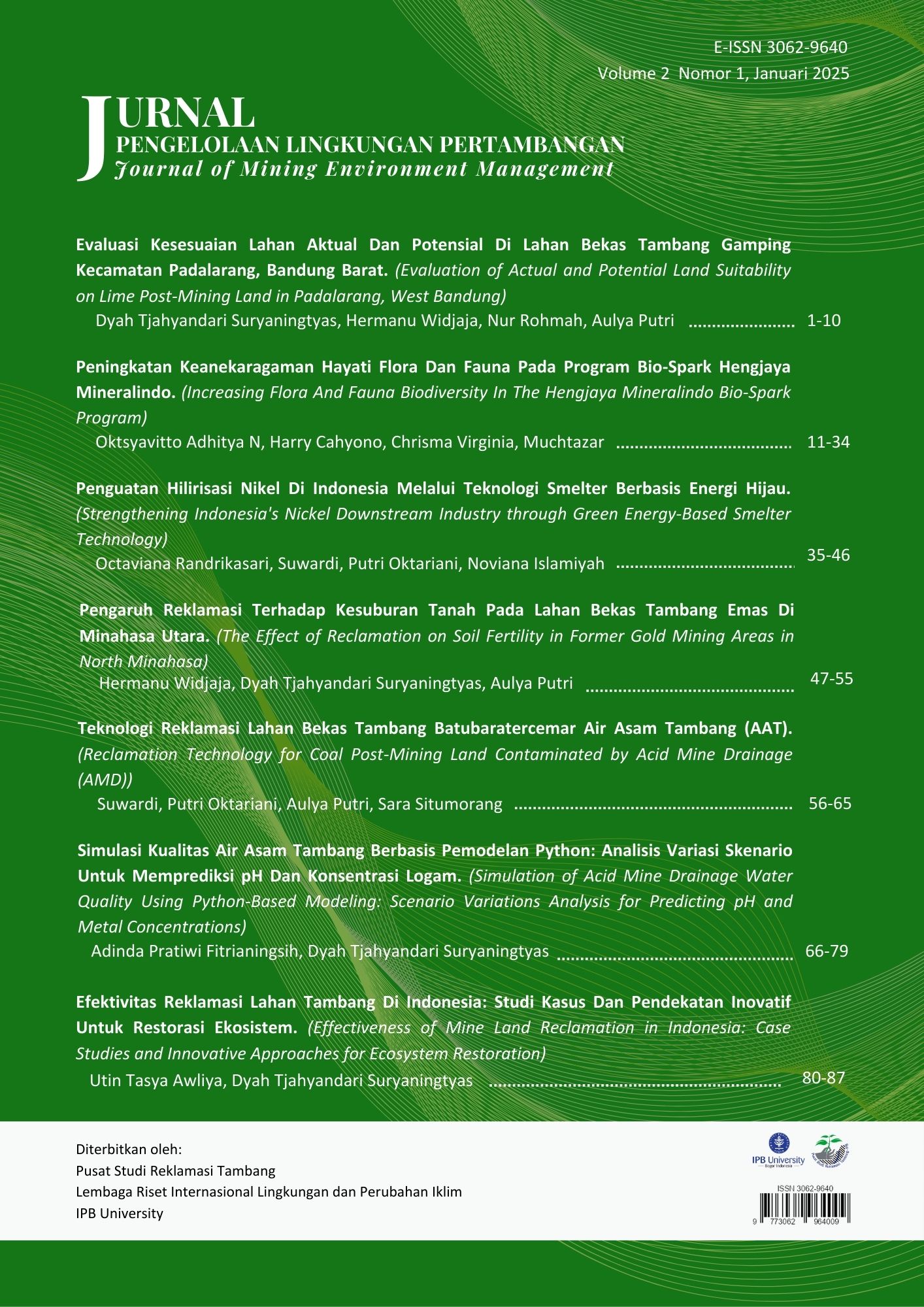Increasing Flora And Fauna Biodiversity In The Hengjaya Mineralindo Bio-Spark Program
Abstract
Indonesia as a country geographically located between the Asian Continent and the Australian Continent, commonly called the Wallace region, consequently Indonesia have an abundance of flora and fauna. Over time, the diversity of flora and fauna that exist can be threatened by increased human activities such as mining, and others. PT Hengjaya Mineralindo, a nickel mining company in the Sulawesi region, is aware of the importance of maintaining the biodiversity of flora and fauna around its operational area. The company committed to establishing a High Conservation Value Area of 196.78 ha called BIO-SPARK (Biodiversity Study and Protection for Advancing Research and Knowledge). Based on its diversity index, mammals in the arboretum area have a value of 1.28, which is included in the moderate category, While the avifauna in the arboretum area has a value of 3.35, this value is included in the high category. Based on the evenness index of mammal and avifauna species, the value is close to 1, which means that the distribution of individuals between species is relatively even, and the dominance index is close to 0, which means that there is no dominant species at the monitoring area. The migration of several species from their previous location to the arboretum area, along with the abundance of food supplies available, can lead to the addition of new species. Thus, with the arboretum area, it can be a place to maintain the sustainability of flora and fauna around the PT Hengjaya Mineralindo mining area
References
Alikodra, H. (2010). Teknik Pengelolaan Satwaliar dalam Rangka Mempertahankan Kenekaragaman Hayati Indonesia. Bogor: IPB Press.
Coates, B. J., David, B. K., Kartikasari, S., Lambert, Frank, Rini, D., . . . D, M. (2000). Panduan Lapangan Burung-Burung di Kawasan Wallaceae Sulawesi, Maluku dan Nusa Tenggara. Bogor: Birdlife International-Indonesia Programme.
Desmukh, I. (1992). Ekologi Tropika. Bandung: Penerbit ITB.
Devi, S. R., Hasyim, M. A., Mulyono, R. M., Firizki, D. T., Hasanudin, M. A., & Pratama, M. R. (2020). Inventarisasi Avifauna di Coban Kodok, Desa Sukomulyo Kecamatan Pujon Kabupaten Malang. Journal of Tropical Biology, 8(3), 163-170. doi:10.21776/ub.biotropika.2020.008.03.04
Gurung, D., Katel, O., Tobgay, T., Dorji, P., Phuntsho, T., Acharja, I., . . . Norbu, W. (2022). Protocol for Rapid Biodiversity Assessment. Royal Society for Protection of nature.
Hidayat, W., Rustiadi, E., & Kartodihardjo, H. (2015). Dampak Pertambangan Terhadap Perubahan Penggunaan Lahan dan Kesesuaian peruntukan Ruang (Studi Kasus Kabupaten Luwu Timur Provinsi Sulawesi Selatan). Jurnal Perencanaan Wilayah dan Kota, 26(2), 130-146.
Keong, C. Y. (2015). Sustainable Resource Management and Ecological Conservation of Mega-Biodiversity: The Southeast Asian Big-3 Reality. International Journal of Environmental Science and Development, 16(11).
Konsorsium Revisi HCV Toolkit Indonesia. (2009). Panduan Identifikasi Kawasan Bernilai Konservasi Tinggi di Indonesia. Balikpapan: Tropenbos International Indonesia Programme.
Latupapua, L., & Sahusilawane, J. (2023). Upaya Perlindungan Satwaliar Untuk Mempertahankan Keanekaragaman Hayati Di Negeri Hutumuri, Kecamatan Leitimur Selatan, Kota Ambon. Maanu: Jurnal Pengabdian Kepada Masyarakat, 1(1), 20-25.
Leus, K., Macdonald, A., Burton, J., & Rejeki, I. (2016). Babyrousa Celebensis. The IUCN Red List of Threatened Species. doi:https://dx.doi.org/10.2305/IUCN.UK.2016-1.RLTS.T136446A44142964.en
Mackinnon, J., Phillips, K., & Van Ballen, B. (2010). Burung-Burung di Sumatera, Jawa, Bali, dan Kalimantan. Bogor: Puslitbang Biologi LIPI.
Magurran, A. E. (1988). Ecological Diversity and Its Measurement. New Jersey: Pricenton University Press.
Maryanto, I., Maharadatunkamsi, Achmadi, A., Wiantoro, S., Sulistyadi, E., Yoneda, M., & Suryanto, A. S. (2019). Checklist of the mamals of indonesia (3rd ed.). Bogor: Indonesian Institute of Sciences.
Mustari, A. (2020). Manual Identifikasi dan Bio-ekologi Spesies Kunci di Sulawesi. Bogor: IPB Press.
Rosyidy, M. K., & Wibowo, A. (2020). GIS-based spatial model for habitatsuitability of Babirusa (Babyrousa celebensis), in Gorontalo province. Journal of Geography of Tropical Environments, 4(1), 35-45.
Saroyo, S. (2011). Konsumsi mamalia, burung dan reptil liar pada masyarakat sulawesi utara dan aspek konservasinya. Jurnal Bios Lagos, 1(1), 25-31.
Setia, T. (2011). Penyebaran Biji Oleh Satwa Liar di Kawasan Pusat Pendidikan Konservasi Alam Bodogol dan Pusat Riset Bodogol, Taman Nasional Gunung Gede Pangrango, Jawa Barat. Vis Vitalis, 1(1), 1-8.
Setiadi, A., Prianto, A. A., Alhumaira, B. S., & Khasanah, S. N. (2023). Konservasi Keanekaragaman Hayati Endemik Melalui Ecology, Socio-Economic, dan Socio-Cultural Approach (Studi Pada Taman Kehati Kokolomboi, Sulawesi Tengah). Jurnal CSR, Pendidikan, dan Pemberdayaan Masyarakat, 4(1), 244-254.
Soerianegara, I., & Indrawan, A. (1998). Ekologi Hutan Indonesia. Bogor.
Sujatnika PJ, S. T. (1995). Melestarikan Keanekaragaman Hayati Indonesia: Pendekatan Daerah Burung Endemik. Jakarta: PHPA/Birdlife International-Indonesia Programme.
Susanty, F. H. (2020). Pola Kerapatan dan Keragaman Tegakan Hutan Dipterokarpa Sekunder. Jurnal Penelitian Hutan Tanaman, 17(1), 41-51.
Sutarno, & Setyawan, A. D. (2015). Biodiversitas Indonesia: Penurunan dan Upaya Pengelolaan Untuk Menjamin Kemandirian Bangsa. Pros Sem Nas Masy Biodiv Indon, 1(1), 1-13. doi:10.13057/psnmbi/m010101
Swift, M., Izac, A. M., & Noordwjik, M. V. (2004). Biodiversity and Ecosystem Services in Agricultural Landscapes - Are we asking the right questions? Agriculture, Ecosystem and Environment, 112-134. doi::10.1016/j.agee.2004.01.013
Tortosa, F., & Villafuerte, R. (2000). Habitat Selection by Flocking Wintering Common Cranes (Grus grus) at Los Pedroches Valley, Spain. Etologia, 8, 21-24.
Wardhani, F. K., Rofi'i, I., Kusumandari, A., Subrata, S. A., & Wianti, K. F. (2020). Peran Tumbuhan Bawah Dalam Kesuburan Tanah di Hutan Pangkuan Desa Pitu BPKH Getas. Jurnal Manusia dan Lingkungan, 27(1), 14-23. doi:10.22146/jml.49668
Wulandari, A., Sari, R., & Sulistyaningsih, D. (2023). Perbedaan mamalia di Sulawesi dan di Sumatra dari sudut pandang biodiversitas. Jurnal Pengelolaan Sumberdaya Alam Lingkungan Wilayah Pesisir, 1(1).
WWF. (2012). Living Planet Report. The Netherlands: WWF.
Yusuf, Rosyid, A., Korja, I. N., Muhasinin, Hamsi, M. S., & Ramadan, M. (2024). Monitoring of TogeanensisBabirusa (Babyrousatogeanensis) PopulationinTogean Islands National Park. Jurnal Ilmiah Matematika dan Ilmu Pengetahuan Alam, 21(1), 53-61. doi:10.31851/sainmatika.v21i1.14849
Copyright (c) 2025 Oktsyavitto Adhitya Nugroho, Harry Cahyono, Chrisma Virginia, Muchtazar

This work is licensed under a Creative Commons Attribution-NonCommercial-ShareAlike 4.0 International License.














